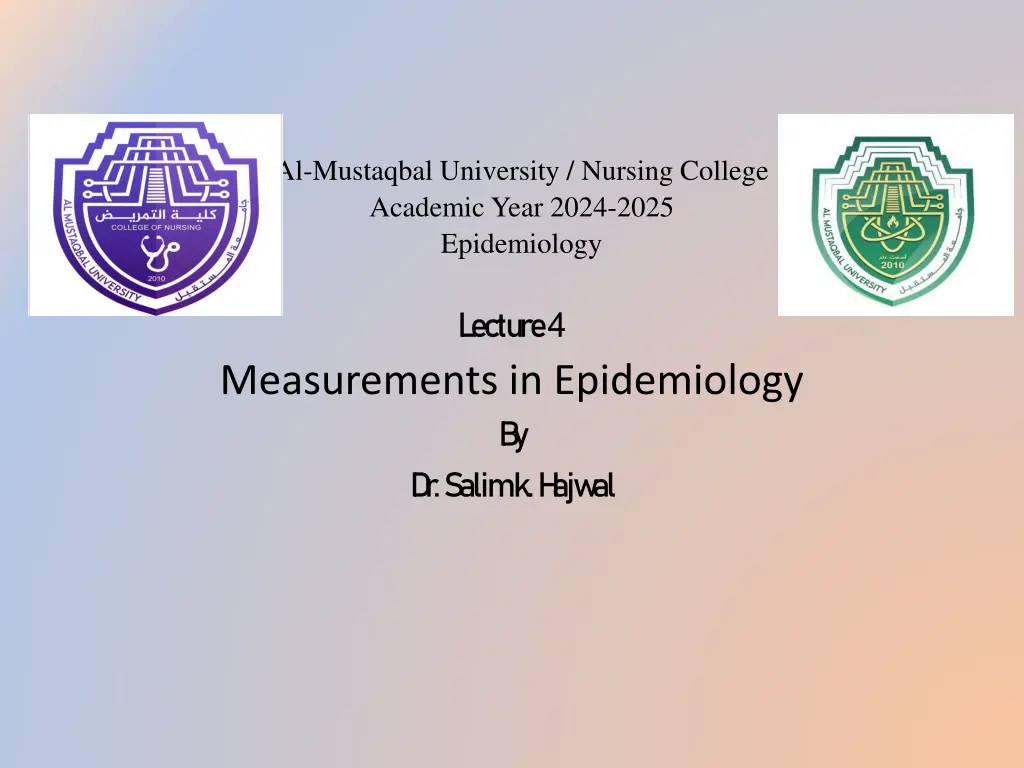
Epidemiologic Measures and Rates Overview
Learn about the four types of epidemiologic measures - count, ratio, proportion, and rate - and understand their significance in epidemiology. Explore how these measurements play a crucial role in evaluating disease frequency within populations and assessing health outcomes. Dive into the concepts of crude death rates and epidemiologic rates to gain a comprehensive understanding of public health data analysis.
Download Presentation

Please find below an Image/Link to download the presentation.
The content on the website is provided AS IS for your information and personal use only. It may not be sold, licensed, or shared on other websites without obtaining consent from the author. If you encounter any issues during the download, it is possible that the publisher has removed the file from their server.
You are allowed to download the files provided on this website for personal or commercial use, subject to the condition that they are used lawfully. All files are the property of their respective owners.
The content on the website is provided AS IS for your information and personal use only. It may not be sold, licensed, or shared on other websites without obtaining consent from the author.
E N D
Presentation Transcript
Al-Mustaqbal University / Nursing College Academic Year 2024-2025 Epidemiology L ecture 4 Measurements in Epidemiology B y D r. Salimk. H ajw al
The four types of epidemiologic measures are: 1. Count 2. Ratio 3. Proportion 4. Rate
Count Count The performed epidemiology is a count. Count of the number of persons in the group who have a particular disease or a particular characteristics. E.g. cases of influenza reported in New York, during January of a particular year. simplest and most measurement frequently quantitative in
Ratio Ratio Ratio is numerical expression, which indicates the relationship in quantity between two parts. Obtained by dividing one quantity by another. Example: (20) male patients were attended the clinic and (10 )female patients the ratio of male to female is 2:1.
Proportion Proportion: For a count to be descriptive of a group it must be seen in proportion to it; that is must be divided by the total number in the group. proportions may percentages (%) be expressed as
Rate Rate Rate: is the quantity amount or degree of something measured in specific period of time. It is similar to proportion but it is calculated in a specific period(usually one year)
Epidemiologic rates contain the following elements: 1- Disease frequency. 2- Unit size of population. 3- Time period during which an event occurs.
The crude death rate: reflects all deaths in the population regardless of age or cause of death. The crude death rate presents a picture of the overall health status of the population. (e.g. all cancer deaths in 2000). ?????? ?? ????? ? ?? ?? ?? ?? ? ? ?? ?? ?? ?? ?? ?? ?? ?? ?= --------------------------------------------- - ------ * 1000 ?????? ?? ?????? ????????? ??????????? ?????????n
Specific Rate: Rates for specific segments/groups of the population (e.g. sex, age, race, cause of death, cancer site).
Prevalence Prevalence The number of existing cases depends on the number of people who developed their illness in the past and have continued to be ill at the present time (i.e. old and new).
Incidence Is defined as the number (No.) of new cases of disease. Incidence is a measure of a disease developed in a person who did not have the disease. Transition from non disease to disease status.
Incidence rate Incidence rate No. of new cases in the population during period/ no of population at risk of developing the disease at that period. specific
Incidence is the measure of disease developing in a person who did not have the disease .
Factors of`Influencing prevalence rate : 1.The number of new cases( incidence ): if the incidence increase the prevalence will increase. 2.The severity of illness :if the deaths increase the prevalence will decrease ,if the disease is easily cured the prevalence also decrease. 3.The duration of illness: if the duration of the disease increase the prevalence will increase.
Period prevalence: The prevalence of a particular disease in a longer period such as one month , six months , one year or even more (life time prevalence).
Point prevalence : Is used to know how much of a particular disease is present in a population at a particular point in time(one day ) , exampleDec.31,2019.
Relationship between incidence and prevalence Incidence Prevalence Cure Death
Vital statistics: Tools used to evaluate the health status of the community . By vital statistics we refer to data collected from ongoing recording ,registration of all vital events ( birth, deaths ,fetal deaths ,marriages and divorces ). The nurse or physician is responsible for filling the certificates of death , birth and fetal death
Crude Birth Rate (CBR) Crude Birth Rate (CBR) Crude Birth Rate (CBR) :Is the No. of live births per 1000 population of certain locality and year . Number of live birth (during a year) ------------------------------------------------X (1000) Mid year population in certain locality
Birth rate is generally high in developing countries including Iraq , due to : 1- high fertility rates due social and traditional motives . 2- poor family planning facilities 3 factors related to marriage ( the youngest age of marriage is associated with long childbearing period .
Crude Death Rate ( CDR) Crude Death Rate ( CDR) = = Total number of deaths for all ages and causes ------------------------------------------------------*1000 Mid year population (MYP)






















